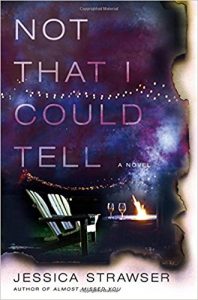3 Ways to Use “Accidental Research” to Write More Authentic Fiction
 It’s a run-of-the-mill question, but one that comes up again and again: “What sort of research did you do for this story?”
It’s a run-of-the-mill question, but one that comes up again and again: “What sort of research did you do for this story?”
Whether we’re writing contemporaries or historicals, readers like to know that we’ve done due diligence, and perhaps to discern how much of our fiction could conceivably be real. Sometimes, the answer is straightforward: We shadowed a professional, read up on a topic, studied a field. But sometimes, the answer is more roundabout—when the author’s subject matter is inherent to their non-authorial life, of real significance to them.
Those are the stories I love most: in which you can feel the author’s passion through the page.
I’m fascinated by the answers creatives seek without consciously equating them to future work—and the many ways, both subtle and overt, that they eventually translate to the page. The “research” we don’t yet recognize as such is my favorite kind, as both an author and a reader.
Take my own new release: In Not That I Could Tell, a woman falls off the grid on the heels of a neighborhood girls’ night, and the ensuing investigation into her pending divorce raises questions of whether domestic violence was a factor.
Thus, to the question of research, the basic answer is that I interviewed a detective about how certain missing persons cases are handled in small-town Ohio. I read up on my setting’s history, culture and landmarks, as well as minor plot points, such as custodial issues in step-families. And I interviewed a doctor in the same field as my husband-under-suspicion character to inquire about how public speculation might affect his professional practice.
But none of that got to the heart of the real-life experiences that fueled my novel. That part came earlier—much earlier. And at the time it wasn’t research at all.
I lost a friend to domestic violence in 2008. There’s been a lot of talk lately about how soon is “too soon” to start discussing a societal issue that underlies a tragedy, but while everyone processes grief differently, I can say that in my case—while I did need some time to feel ready to get personally involved in the cause—my thirst for better understanding of the contributing factors was immediate and intense.
Suddenly it seemed as if domestic violence was everywhere—in the news, on the football field, even outside the Grammy Awards. I wanted so badly to make sense of what seemed senseless. And I wanted, impossibly, to make up for my failure to help my friend by seeking out ways to help someone else.
Within a couple of years, I was lending my writing and editing skills to a public awareness campaign for my local chapter of the YWCA. I toured the women’s shelter, I learned about the 24-hour hotline, I spoke with board members, volunteers, victims. And every bit of it—alongside my own brokenhearted reckoning—was informing the underlying themes and questions driving the novel I’d write several years later.
I just didn’t know it yet.
When I signed a two-book contract with my first novel completed and my agent asked, “What’s next?” I told her I didn’t know.
But a part of me already did.
Often the story you should write next is the one you’ve been researching without even knowing you planned to write it. Because we write best, after all, when we have something important to say. You’ll know you’ve done it the first time you face that research question in an interview: The answer won’t be easy. Instead, you’ll think, Oh, my. Where do I begin?
With that in mind, here are three things to think about as you suss out your next story idea or simply look to enrich your work-in-progress.
- What are you inherently drawn to that might one day make for heartfelt fiction?
In Jodi Picoult’s Leaving Time, the protagonist’s love of elephants made me love them too, so fascinatingly drawn were her descriptions and observations. It was no surprise to later learn that Picoult herself had visited Botswana and learned firsthand about the crisis the animals were facing. But how did she get there in the first place?
It all started when she read something about lifelong bonds between mother elephants and their children, at a time when she was struggling with being a new empty-nester. She related; she was intrigued. (You can read more about her inspiration, her work with sanctuaries, and even see her in a National Geographic video here.)
- What do you have to see for yourself?
Thriller writer Barbara Taylor Sissel married a warden and lived for a time on the grounds of a first-offender prison that she likens more to a college campus than to any steel-barred facility you might imagine. The experience would later be so pivotal to her work that it comprises a full paragraph in the author bio on her website: “I got to know them,” she writes. “I heard their stories, how they came to commit their crimes, from petty theft of a pig to manslaughter. I heard about their families … It was upfront, hands-on learning, and when I sat down to write, that’s what I wrote about. A guy who goes to prison. Injustice versus justice. What is it? Where’s the line? What is the nature of forgiveness? Why is it so hard?”
- What stays with you?
When arranging to tour a domestic violence shelter, I was unprepared for the realization that would hit me when I received my driving directions. No street address was given, only instructions to turn at various landmarks. What a chill, to fully comprehend that it was not safe to give a road or house number.
That icy fear gripped me again when I arrived and saw the “panic buttons” installed through the shelter’s grounds. A necessity, I was told, as enraged spouses and boyfriends have attempted to scale the fence and even assaulted employees coming and going.
Imagine having that fear follow you, even when you’ve arrived at the safest place you can think of, a place that is designed for the sole purpose of keeping you safe. It haunts me to this day. That detail doesn’t appear in my novel, but the implications of that realization, of that fear, run deep beneath the pages.
“Where do you get your ideas?” is another favorite question of interviewers and readers alike. I guess it’s fitting that this sort of research answer goes hand in hand with that one. When it does, the result can be that sturdy bridge we’re all looking for: solidly connecting idea and execution, and welcoming readers across.
—
Jessica Strawser jessicastrawser.com is the editor-at-large at Writer’s Digest magazine, where she served as editorial director for nearly a decade and became known for her in-depth cover interviews with such luminaries as David Sedaris and Alice Walker. She’s the author of the book club favorites Almost Missed You, now new in paperback, and Not That I Could Tell, a Book of the Month selection and Barnes & Noble Best New Fiction pick for March 2018. She has written for The New York Times Modern Love, Publishers Weekly and other fine venues, and lives with her husband and two children in Cincinnati. Connect with her on Twitter @jessicastrawser and on Facebook @jessicastrawserauthor.
NOT THAT I COULD TELL
An innocent night of fun takes a shocking turn in Not That I Could Tell, the next page-turner from Jessica Strawser.
 When a group of neighborhood women gathers, wine in hand, around a fire pit where their backyards meet one Saturday night, most of them are just ecstatic to have discovered that their baby monitors reach that far. It’s a rare kid-free night, and they’re giddy with it. They drink too much, and the conversation turns personal.
When a group of neighborhood women gathers, wine in hand, around a fire pit where their backyards meet one Saturday night, most of them are just ecstatic to have discovered that their baby monitors reach that far. It’s a rare kid-free night, and they’re giddy with it. They drink too much, and the conversation turns personal.
By Monday morning, one of them is gone.
Everyone knows something about everyone else in the quirky small Ohio town of Yellow Springs, but no one can make sense of the disappearance. Kristin was a sociable twin mom, college administrator, and doctor’s wife who didn’t seem all that bothered by her impending divorce–and the investigation turns up more questions than answers, with her husband, Paul, at the center. For her closest neighbor, Clara, the incident triggers memories she thought she’d put behind her–and when she’s unable to extract herself from the widening circle of scrutiny, her own suspicions quickly grow. But the neighborhood’s newest addition, Izzy, is determined not to jump to any conclusions–especially since she’s dealing with a crisis of her own.
As the police investigation goes from a media circus to a cold case, the neighbors are forced to reexamine what’s going on behind their own closed doors–and to ask how well anyone really knows anyone else.
Category: Contemporary Women Writers, How To and Tips

























